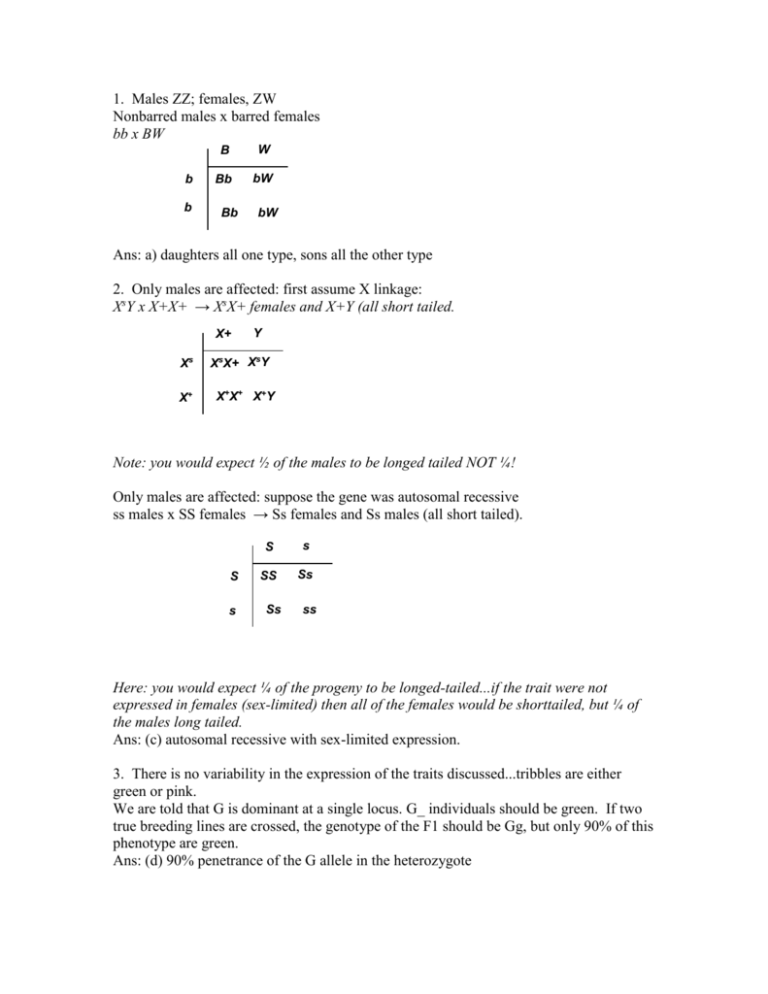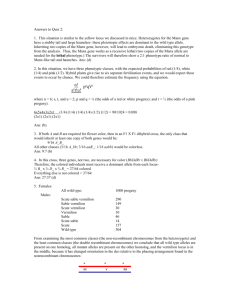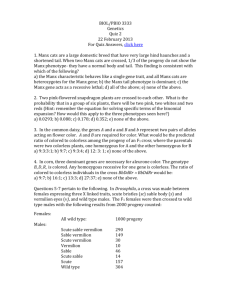progeny numbers
advertisement

1. Males ZZ; females, ZW Nonbarred males x barred females bb x BW b b B W Bb bW Bb bW Ans: a) daughters all one type, sons all the other type 2. Only males are affected: first assume X linkage: XsY x X+X+ → XsX+ females and X+Y (all short tailed. X+ Xs X+ Y XsX+ XsY X+X+ X+Y Note: you would expect ½ of the males to be longed tailed NOT ¼! Only males are affected: suppose the gene was autosomal recessive ss males x SS females → Ss females and Ss males (all short tailed). S s S s SS Ss Ss ss Here: you would expect ¼ of the progeny to be longed-tailed...if the trait were not expressed in females (sex-limited) then all of the females would be shorttailed, but ¼ of the males long tailed. Ans: (c) autosomal recessive with sex-limited expression. 3. There is no variability in the expression of the traits discussed...tribbles are either green or pink. We are told that G is dominant at a single locus. G_ individuals should be green. If two true breeding lines are crossed, the genotype of the F1 should be Gg, but only 90% of this phenotype are green. Ans: (d) 90% penetrance of the G allele in the heterozygote 4. Observed Expected (O-E) (O-E)2 (O-E)2/E 54 50 4 16 0.32 55 50 5 25 0.5 45 50 -5 25 0.5 46 50 -4 16 0.32 200 1.64 =c2 Degree of freedom = 3 Let independent assortment be the null hypothesis If so, then we would expect equal numbers in each category The chi square value is 1.64, at three degrees of freedom. This value is CONSISTENT with the hypothesis that the genes are segregating independently- they are far enough apart on the X chromosome that the appear to be unlinked. Ans: (b) 0.9>p>0.5; no linkage 5. Females: All wild type: 1000 progeny Scute sable vermilion Sable vermilion Scute vermilion Vermilion Sable Scute sable Scute Wild type 290 149 30 10 46 14 157 304 Males: From examining the most common classes (the nonrecombinant chromosomes from the heterozygote) and the least common classes (the double recombinant chromosomes) we conclude that all wild type alleles are present on one homolog, all mutant alleles are present on the other homolog, and the vermilion locus is in the middle, because it has changed orientation in the dco relative to the phasing arrangement found in the nonrecombinant chromosomes: + sc sc-v interval: sc 157 v sa 149 v 10 sc sa 14 330/1000 = 0.33 = 33 map units + v + sa v-sa interval: sa 46 sc-v 30 v 10 sc sa 14 100/1000 = 0.10 = 10 map units sc-v interval: Ans: (d) 33 m.u. 6. To solve this problem, we essentially need to work backwards. There will be eight phenotypic classes generated from the cross as depicted, a pair of non-recombinant or parental chromosomes, two pairs of single cross-over classes, and a pair of double cross over classes: sc -------------33-------- v ----10--- sa sc + + v + X sa sc + + + v sa nonrecombinant (parental) nonrecombinant (parental) sc v sa + ++ single crossover between sc and v single crossover between sc and v sc + sa +v+ single crossover between v and sa single crossover between v and sa sc v + + + sa double crossover double crossover It is the frequency of the + v + class that we are asked to calculate. From the previous problem, we expect 10% of the meiotic products to show a crossover in the vermilion - sable gene interval. The meiotic products representing a crossover in this interval will include both single and double crossover classes. Moreover, from the previous problem, there is evidence of interference, because (0.33)(0.1)(1000) = an expected value of 33 DCOs, but only 24 were detected. This is a coefficient of coincidence of 0.74- only 74% of the expected double crossovers were observed. Let’s first calculate the results expected for the DCO classes. If we were screening 1500 progeny, the number we would expect in this category would be (0.33)(0.1)(0.74)(1500) = 36.6 progeny. Therefore, between 18-19 progeny would be expected in each DCO class. Again, the frequency of crossovers in the v sa interval represents the total number of crossovers, so the number of SCOs would be [1500 (0.1)] – DCO class. This would represent 113 individuals in both classes, or 57 individuals in the + v + class. Note that 57 (sc + sa) + 57 (+ v +) +18 (sc v +) +18(+ + sa) = 150/1500 = 0.1 Ans: (e) none of the above. (I counted (a) as correct on the quiz, but you should be able to go through this logic. Also see problem 11, chapter 12, in Thompson. 7. Affected parent gives rise to affected children; about ½ of children are affected, regardless of sex. Ans: True, these are characteristics of an autosomal dominant trait. 8. If we look at the progeny, the nail patella disease gene segregates with the IB locus, and the i gene segregates with the wild type locus in 15/18 progeny. This is greater than the 1:1:1:1 distribution we would predict on the basis of independent assortment. OD obs exp (O-E) (O-E)2 (O-E)2/ E BD 1.00 4.50 -3.50 12.25 2.72 O+ 8.00 4.50 3.50 12.25 2.72 B+ 7.00 4.50 2.50 6.25 1.39 2.00 4.50 -2.50 6.25 1.39 18.00 18.00 8.22 >7.81 RF = 3/18 = 0.167 = 16.7 m.u. Now suppose individual III-1 were crossed to a normal woman with type O blood: What would be the chances of producing a child with nail patella syndrome and type O blood? IB NP X X i + i NP i + i i + + 8. 0.167/2 = 0.083 Ans: (b) Spore number 1 2 3 4 5 6 7 8 totals -------------------------------------------------Ascus Types------------------------------------------- 1 2 3 4 5 6 7 ab ab +b +b a+ a+ ++ ++ 90 ab ab ++ ++ +b +b a+ a+ 10 +b +b +b +b a+ a+ a+ a+ 1 ++ ++ ++ ++ ab ab ab ab 699 a+ a+ a+ a+ +b +b +b +b 5 ab ab +b +b ++ ++ a+ a+ 190 ab ab ++ ++ ++ ++ ab ab 5 Identify the number of second division segregation patterns for the B gene: 10 + 5 = 15 (15/1000) x ½ = .75 map unit 9. Ans: (e) none of the above 10. From the above, the tetratype (TT) classes are (1 = 90), (2 = 10) and 6 (190) The nonparental ditype (NPD) classes are (3 = 1), (5 = 5), so TT = 290 and NPD = 6. RF = (½ TT + NPD)/total asci ≈ 0.151 = 15.1 map units (book formula) RF = (½ TT + 3 NPD)/total asci ≈ 16.3 map units (class formula) Ans: (c); 16 map units.









